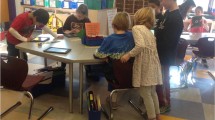Abstract
This paper seeks to contribute to the growing literature on children and computer programming by focusing on a programming language for children in Kindergarten through second grade. Sixty-two students were exposed to a 6-week curriculum using ScartchJr. They learned foundational programming concepts and applied those concepts to create personally meaningful projects using the ScratchJr programming app. This paper addresses the following research question: Which ScratchJr programming blocks do young children choose to use in their own projects after they have learned them all through a tailored programming curriculum? Data was collected in the form of the students’ combined 977 projects, and analyzed for patterns and differences across grades. This paper summarizes findings and suggests potential directions for future research. Implications for the use of ScratchJr as an introductory programming language for young children are also discussed.







Similar content being viewed by others
References
Bers, M. U. (2007). Project InterActions: A multigenerational robotic learning environment. Journal of Science and Technology Education., 16(6), 537–552.
Bers, M. U. (2010). Beyond computer literacy: Supporting youth’s positive development through technology. New Directions for Youth Development, 128, 13–23.
Bers, M. U. (2012). Designing digital experiences for positive youth development: From playpen to playground. Oxford: Oxford University Press.
Bers, M. U., & Horn, M. S. (2010). Tangible programming in early childhood: Revisiting developmental assumptions through new technologies. In I. R. Berson & M. J. Berson (Eds.), High-tech tots: Childhood in a digital world (pp. 49–70). Greenwich, CT: Information Age Publishing.
Bers, M. U., Ponte, I., Juelich, K., Viera, A., & Schenker, J. (2002). Teachers as designers: Integrating robotics into early childhood education. Information Technology in Childhood Education, 2000(1), 123–145.
Chen, X. (2013). STEM attrition: College students’ paths into and out of STEM fields (NCES 2014-001). Washington, DC: National Center for Education Statistics, Institute of Education Sciences, U.S Department of Education.
Clements, D. H. (1999). The future of educational computing research: The case of computer programming. Information Technology in Childhood Education Annual, 1999(1), 147–179.
Clements, D. H., & Gullo, D. F. (1984). Effects of computer programming on young children’s cognition. Journal of Educational Psychology, 76(6), 1051–1058. doi:10.1037/0022-0663.76.6.1051.
Clements, D. H., & Meredith, J. S. (1992). Research on logo: Effects and efficacy. Retrieved from http://el.media.mit.edu/logo-foundation/pubs/papers/research_logo.html
Flannery, L. P., & Bers, M. U. (2013). Let’s dance the “Robot Hokey-Pokey!”: Children’s programming approaches and achievement throughout early cognitive development. Journal of Research on Technology in Education, 46(1), 81–101.
Flannery, L.P., Kazakoff, E.R., Bontá, P., Silverman, B., Bers, M.U., and Resnick, M. (2013). Designing ScratchJr: Support for early childhood learning through computer programming. In Proceedings of the 12th international conference on interaction design and children (IDC’13) (pp. 1–10). New York, NY: ACM. doi:10.1145/2485760.2485785
Henderson, P. B., Cortina, T. J., Hazzan, O., & Wing, J. M. (2007). Computational thinking. In Proceedings of the 38th ACM SIGCSE technical symposium on computer science education (SIGCSE’07) (pp. 195–196). New York, NY: ACM Press.
Kazakoff, E., & Bers, M. (2012). Programming in a robotics context in a kindergarten classroom: The impact on sequencing skills. Journal of Educational Multimedia and Hypermedia, 21(4), 371–391.
Landivar, L. C. (2013). Disparities in STEM employment by sex, race, and hispanic origin [PDF Document]. Retrieved from http://www.census.gov/prod/2013pubs/acs-24.pdf
Langdon, D., McKittrick, G., Beede, D., Khan, B., and Doms, M. (2011). STEM: Good jobs now and for the future [PDF Document]. Retrieved from http://www.esa.doc.gov/sites/default/files/reports/documents/stemfinalyjuly14_1.pdf
Lee, I., Martin, F., Denner, J., Coulter, B., Allan, W., Erickson, J., et al. (2011). Computational thinking for youth in practice. ACM Inroads, 2(1), 32–37.
Papert, S. (1980). Mindstorms: Children, computers, and powerful ideas. New York: Basic Books.
Papert, S. (2000). What’s the big idea? Toward a pedagogy of idea power. IBM Systems Journal, 39(3.4), 720–729.
Resnick, M. (2013). Learn to code, code to learn: How programming prepares kids for more than math. EdSurge (May 8, 2013). Retrieved from https://www.edsurge.com/n/2013-05-08-learn-to-code-code-to-learn
Resnick, M., Maloney, J., Monroy-Hernandez, A., Rusk, N., Eastmond, E., Brennan, K., et al. (2009). Scratch: Programming for all. Communications of the ACM, 52(11), 60–67.
Wing, J. M. (2006). Computational thinking. Communications of the ACM, 49(3), 33–35.
Acknowledgments
This research was supported by the National Science Foundation (NSF DRL-1118664) and the Scratch Foundation. The researchers would also like to extend a thank you to the many teachers, staff, students, and parents who participated.
Author information
Authors and Affiliations
Corresponding author
Rights and permissions
About this article
Cite this article
Portelance, D.J., Strawhacker, A.L. & Bers, M.U. Constructing the ScratchJr programming language in the early childhood classroom. Int J Technol Des Educ 26, 489–504 (2016). https://doi.org/10.1007/s10798-015-9325-0
Accepted:
Published:
Issue Date:
DOI: https://doi.org/10.1007/s10798-015-9325-0




